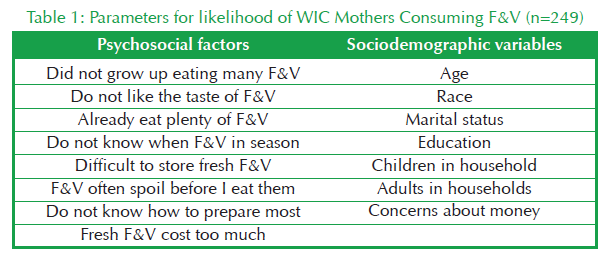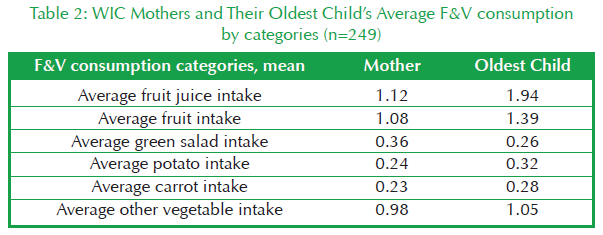Impact of Personal Preference and Motivation on Fruit and Vegetable Consumption of WIC Participating Mothers and Children in Atlanta
The primary objective of the present study was to examine the relationship between psychosocial factors (personal preferences and motivation for healthy eating habits) and the consumption of fruit and vegetables (F&V) among mothers and children participating in the WIC program in the metro-Atlanta area. Socio-demographic factors were also examined as possible confounders of the relationship with F&V consumption. Understanding personal preferences and motivation would allow the WIC program to improve the effectiveness of its nutrition education efforts to increase F&V consumption .
Participants were selected from two metro-Atlanta WIC agencies and interviewed between April and October, 2009. All 249 participants of the study met the following inclusion criteria:
- at least 18 years of age,
- English as the primary language;
- received WIC coupons or vouchers at the WIC clinic;
- had at least one child receiving WIC vouchers between the age of 1 and < 5 years; and
- received WIC vouchers on date of interview.
Measure of F&V consumption and psychosocial and sociodemographic factors
The baseline survey asked six questions pertaining to F&V intake for the mother and the oldest child receiving the food voucher. The questions asked about the daily or weekly consumption of six different categories of F&V: fruit juice, fruit, green salad, potatoes (not including french fries), carrots, other vegetables.
The psychosocial factors included in this study focused on personal preference and motivation factors of F&V consumption for participants. A total of eight subtopics of personal preference and motivation were asked (Table 1) with three response options: ‘‘Disagree,’’ ‘‘Agree,’’ and ‘‘Neutral.’’ Seven sociodemographic variables were identified (Table 1).

Fruit juice and fruits consumption were the highest category of F&V intake
For both mother and child, fruit juice and fruit had the highest average intake. Carrots, potatoes, and green salad had the lowest average daily consumption for both mother and child (Table 2).

Categorical breakdown for F&V consumption is important for development of new WIC initiatives focused on F&V. Fresh fruits and green leafy vegetables are highly recommended for a healthy diet2. Fruit juice consumption has been criticized for high sugar content, often with sparse nutritional benefits3,4.Further examination of knowledge of F&V consumption will be benefi cial in developing education programs and tailoring new WIC initiatives toward healthier diets.
Only 28% of mothers and 44 % of their oldest children consumed more than five servings of F&V daily
The average total daily intake of F&V among mothers was 3.92 servings, and 5.25 for the oldest child.
The analysis of perception of F&V intake showed that the majority of mothers in this study believe they ‘‘already consume plenty of F&V.’’ However, only 28% of mothers (and 44 % of oldest children) met the suggested daily intake of five servings of F&V a day.
Not knowing how to prepare F&V and spoilage of F&V before eating them were significantly related to F&V consumption of mothers
The demographic characteristics did not differ signifi cantly by whether the F&V criterion was met. However, those who did not meet the criterion showed a higher percentage of being concerned about not having enough money.
Of the 15 independent variables, only three showed a significant difference between mothers who met criteria and those who did not: ‘‘Already eat plenty of F&V’’ (P =0.04); ‘‘Fruits and vegetables often spoil before I eat them’’ (P=0.02); and ‘‘Do not know how to prepare most F&V’’ (P =0.04). This last item is consistent with findings from a previous study in which WIC recipients claimed to spend little time cooking each day, rarely used recipes, and prepared larger meals only on weekends5.
| Food storage and preparation resulted in signifi cant differences in meeting criteria for F&V consumption. Future education and research initiatives should offer cooking classes and focus on teaching participants how to use recipe books. |
For children, only two variables had a signifi cant different in outcome of child’s F&V intake: ‘‘Already eat plenty of F&V’’ (P=0.04); and ‘‘Concerned about money’’ (P=0.02).
References
- Kant AK. Dietary patterns and health outcomes. J Am Diet Assoc. 2004;104: 615-635.
- Centers for Disease Control and Prevention (CDC). Eat a colorful variety of fruits and vegetables everyday for better health. In: U.S Department of Health and Human Services, ed. Fruits & Veggies Matter; 2011.
- Yeh MC, Ickes SB, Lowenstein LM, et al. Understanding barriers and facilitators of fruit and vegetable consumption among a diverse multi-ethnic population in the USA. Health Promot Int. 2008;23:42-51.
- United States Department of Agriculture. Choose my plate: vegetables. http://www.choosemyplate.gov/foodgroups/ vegetables.html. Accessed December 17, 2013.
- Treiman K, Freimuth V, Damron D, et al. Attitudes and behaviors related to fruits and vegetables among lowincome women in the WIC program. J Nutr Educ Behav. 1996;28: 149-156.
